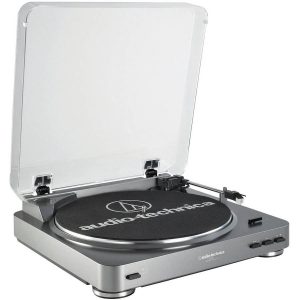Records and How to Enjoy Them
Every so often we feel the need to take on a new, expensive hobby. For me, vinyl records filled that position recently. I’ve been into music since a young age, obviously. And I’ve always heard that the sound of vinyl records is much better than CDs and MP3s. But, until recently I’ve never really given them a serious shot. Having started to build my music library during the time of digital media, I was averse to the idea of analog. I had it in my head, like I’m sure many do, that records always pop and crackle. For that reason, I never knew if they were right for me. A close friend of mine had been into vinyl for quite some time and had planted the seed in my mind. So, I finally decided to go for it and pick up a beginner turntable and some albums.
Turntables

The Audio Technica LP60.
When it comes to new electronics, I always do a lot of research before committing to buying anything. Knowing virtually nothing about records I jumped in to some research and ended up going with the AT-LP60, shown above. I found a lot of sites and forums dedicated to records online. Among them Audio Technica was always a highly-regarded brand. This particular turntable did have some mixed reviews. But, like with anything else, people can become snobs over time. I wasn’t looking to invest a ton of money into something I wasn’t sure I’d like. I just wanted to get something new that was easy to get the hang of.
AT-LP60
- The LP60 is a pretty basic model. It can play two speeds of records – 33 1/3 (or LPs as they’re commonly called), and 45 RPM. Those are the most commonly found record speeds. There are also records that play at 78 RPM, but they’re older and kind of impractical, as each side only plays for about 4 minutes. A lot of other players play at all three speeds, but it isn’t something I was too worried about.
- It’s belt driven, which means there’s a belt between the motor and the platter that spins the records. This can be good for absorbing vibration from the motor. The only downside is that the belts need replaced from time to time. This, however, is a very simple and cheap process.
- The tonearm, at the end of which is the stylus (commonly called needle), unfortunately doesn’t have a counterweight on this model. How much pressure is applied to the stylus while the records play is called the tracking weight. It’s measured in grams, and normally about 1.5 is the best. This model offers no way of adjusting this, though some better models do. It is set to 3 grams by the factory. This can be a little heavy, but helps to keep the stylus from skating or skipping.
- The cartridge is also not replaceable on this model. This is the unit at the end of the tonearm that houses the stylus and basically helps translate the grooves on the record into sound. There are many high-fidelity cartridges out there. These can be pretty pricey, but can increase the sound quality of your records. A cheap turntable can be greatly improved by upgrading the stylus.
- A lot of reviews scrutinize the overall look of the LP60, saying the buttons and components are flimsy. Compared to other models it is a bit small and simplistic, but I find no issue with the construction of the buttons or anything else on it.
Records
I mainly got interested in the idea of records from trying to revisit the songs heard on oldies radio during the early ’90s. Something about taking the trip through time musically by way of analog media sounded just right. There are some good articles out there about the best albums to own on vinyl. Naturally, I checked some out and have been pretty pleased. Being a jazz player I’m also finding there are a lot of good jazz albums to be heard on vinyl. But, one of the most notable aspects of the medium is the wealth of classical albums to be found. Completing my Beethoven collection wasn’t as easy when I was restricted to digital media. With records, any “obscure” classical work can be found in antique shops and used record stores.
Obviously, some older records don’t have the best sound. But, if you clean them and keep them dust and static free they can still be enjoyed. The friction of the stylus tracking across the vinyl creates a lot of static, which can make the record pop and crackle when being played. There are lots of methods for reducing the static, however. Anti-static sprays and cleaners can be applied to the records with a brush or cloth. There are even brushes with bristles made of stainless steel that are 1/6 the diameter of a human hair. These brushes are meant to clean dust off the record and short any static to ground – they can actually be plugged into the ground plug of an electrical outlet.
The Experience
I’ve historically been pretty picky about music. But, with vinyl I’m finding it easier to open up to new kinds of music. It’s got a huge subculture, like many things do these days. It’s one of those things that people can become pretty obsessive over (I mean, just look at this huge article!), and that can turn some into snobs. It’s easy to understand – if you’ve studied something in depth and devoted tons of your time and money to it it’s easy to think you’re the foremost authority on it. But, at the end of the day, it’s all about how you enjoy it. If you’re into dropping thousands of dollars and countless hours on becoming the best of the best when it comes to records, then good for you. Personally, I just enjoy the music and the attention to detail that goes into producing and maintaining a good sound.


